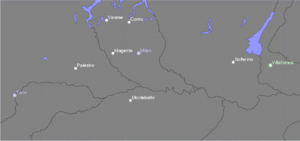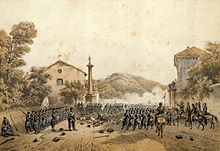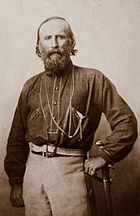Second Italian War of Independence
| Second Italian War of Independence | |
|---|---|
| Part of the wars of Lombardy–Venetia, Piedmont and the Austrian Littoral | |
| Result |
Franco-Sardinian victory |
| Territorial changes | Sardinia annexes from Sardinia. |
312 guns
90 guns[1]
824 guns
1,128 missing
17,054 wounded
2,040 disease related deaths
Total:
25,720 casualties
3,572 wounded
1,268 missing[2]
Total:
unknown
Total:
unknown
The Second Italian War of Independence, also called the Sardinian War, the Austro-Sardinian War, the Franco-Austrian War, or the Italian War of 1859 (Italian: Seconda guerra d'indipendenza italiana; German: Sardinischer Krieg; French: Campagne d'Italie),
A year prior to the war, in the Plombières Agreement, France agreed to support Sardinia's efforts to expel Austria from Italy in return for territorial compensation in the form of the Duchy of Savoy and the County of Nice. The two states signed a military alliance in January 1859. Sardinia mobilised its army on 9 March 1859, and Austria mobilized on 9 April. On 23 April, Austria delivered an ultimatum to Sardinia demanding its demobilization. Upon Sardinia's refusal, the war began on 26 April. Austria invaded Sardinia three days later, and France declared war on Austria on 3 May.
The Austrian invasion was stopped by the arrival of French troops in Piedmont that had begun in late April. The Austrians were defeated at the Battle of Magenta on 4 June and pushed back to Lombardy, where the Franco-Sardinian victory at the Battle of Solferino on 24 June resulted in the end of the war and the signing of the Armistice of Villafranca on 12 July.
Austria ceded Lombardy to France, which, in turn, gave it to Sardinia. Exploiting the collapse of Austrian power in Italy, Sardinia annexed the
Background
The Piedmontese, following their defeat by Austria in the
On 14 January 1858, Felice Orsini, an Italian, led an attempt on Napoleon III's life. The assassination attempt brought widespread sympathy for the Italian unity and had a profound effect on Napoleon III himself, who now was determined to help Piedmont against Austria to defuse the wider revolutionary activities, which governments in Italy might later allow to happen. After a covert meeting at Plombières on 21 July 1858, Napoleon III and Cavour signed a secret treaty of alliance against Austria on 28 January 1859.
France would help Piedmont-Sardinia, if attacked, to fight against Austria if Piedmont-Sardinia gave
Cavour, being unable to get French help unless the Austrians attacked first, provoked Vienna by a series of military maneuvers close to the border. Sardinia mobilised its army on 9 March 1859. Austria mobilised on 9 April 1859 and issued an ultimatum on 23 April demanding the complete demobilisation of the Sardinian Army. When it was not heeded, Austria started a war against Sardinia on 26 April.
The first French troops entered Piedmont on 25 April, and France declared war on Austria on 3 May.[4]
Opposing forces
The French Army for the Italian campaign had 170,000 soldiers, 2,000 horsemen and 312 guns, half of the whole French army. The army, under the command of Napoleon III, divided into five corps: the I Corps, led by
Napoleon III participated in the war and showed up on the battlefield in the belief that it would motivate the French people during the war. That would prove successful.
The Sardinian Army had about 70,000 soldiers, 4,000 horsemen and 90 guns. It was divided into five divisions, led by Castelbrugo,
The Austrian Army fielded more men with 220,000 soldiers, 824 guns and 22,000 horsemen. It was led by
The newly-formed United Principalities of Moldavia and Wallachia also supported the Franco-Italian alliance. Their ruler, Alexandru Ioan Cuza, was given 10,000 rifles and ammunition by Napoleon III. Napoleon III, with his unwavering and very genuine sympathy, also sent a military mission to Bucharest. Encouraged, Cuza formed a new military camp at Ploiești. As a result, Austria had to keep 30,000 troops in Transylvania, which could ill be spared from Italy.[5]
War

The French Army, under

The Austrians, under Gyulai, captured Novara on 30 April and Vercelli on 2 May and advanced on Turin from 7 May onward. The Franco-Sardinian move to strengthen the Alessandria and Po bridges around Casale Monferrato forced the Austrians to halt their advance on 9 May and to fall back on 10 May. Napoleon III left Paris on 10 May, landed at Genoa on 12 May and arrived in Alessandria on 14 May.
Napoleon then took the command of the operations of the war, whose first major clash was the
Napoleon III crossed the Ticino river after the Battle of Turbigo and entered Lobardy. He head on with part of his force and sent many other troops to the north to flank the Austrians. The Austrians planned a resistance before Milan, however they were defeated the Battle of Magenta on 5 May, which caused Gyulai to retreat east of the river Mincio to the quadrilateral fortresses, where he was relieved of his post as commander by the Emperor Franz Josef, who assumed the command himself.


The Piedmontese-French army had taken Milan and slowly marched further east to finish off Austria before Prussia could get involved.
During the retreat, the Austrians won one of their only victories of the war, when Karl von Urban defeated Giuseppe Garibaldi at the Battle of Treponti.
The Austrians found out that the French had halted at Brescia and decided that they should counterattack along the river Chiese. The two armies met accidentally around Solferino, which precipitated a confused series of battles.
A French corps held off three Austrian corps all day at Medole and kept them from joining the larger battle around Solferino, where, after a day-long battle, the French broke through. Ludwig von Benedek with the Austrian VIII Corps was separated from the main force and defended Pozzolengo against the Piedmontese part of the opposing army. It was successful, but the entire Austrian army retreated after the breakthrough at Solferino and withdrew back into the Quadrilateral.[6]
Meanwhile, in the north of Lombardy, the Italian volunteers of
Peace

After the Battle of Solferino, a cease fire is accorded on the 8 July. The two emperors meet on 11 July at Villafranca di Verona and the armistice is signed on the following day - the
Napoleon III signed the armistice with Austria at Villafranca for a combination of reasons. The Austrians had retreated to the Quadrilateral, which would be very costly to overrun. His absence in France had made the country vulnerable to attack. His actions in Italy were being criticised in France. He did not want Cavour and Piedmont to gain too much power, mostly at the expense of his men. He feared involvement of the German states. Most of Lombardy, with its capital, Milan, except only the Austrian fortresses of Mantua and Legnago and the surrounding territory, was transferred from Austria to France, which would immediately cede the territories to Sardinia. The rulers of Central Italy, who had been expelled by revolution shortly after the beginning of the war, were to be restored.
The agreement, made by Napoleon behind the backs of his Sardinian allies, led to great outrage in Piedmont-Sardinia, and Cavour resigned in protest. However, the Villafranca terms never took effect. Although they were reaffirmed by the final Treaty of Zürich in 11 November, the agreement had become a dead letter. The central Italian states were occupied by Piedmont, which would not restore the previous rulers, and France was unwilling to force them to do so.
The Austrians were left to look on in frustration at the French failure to carry out the terms of the treaty. Austria had emerged triumphantly after the suppression of liberal movements in 1849, but its status as a great power on the European scene was now seriously challenged and its influence in Italy severely weakened.
The next year, with French and British approval, the central Italian states (
During the war,
References
- ^ Micheal Clodfelter. "Warfare and Armed Conflicts: A Statistical Reference to Casualty and Other Figures, 1500–2000", 4th Edition. 2017. Page 181.
- ^ a b Clodfelter, p. 181
- ^ Arnold Blumberg, A Carefully Planned Accident: The Italian War of 1859 (Cranbury, NJ: Associated University Presses, 1990); Arnold Blumberg, "Russian Policy and the Franco-Austrian War of 1859", The Journal of Modern History, 26, 2 (1954): 137–53; Arnold Blumberg, The Diplomacy of the Austro-Sardinian War of 1859, Ph.D. diss. (Graduate School of Arts and Sciences, University of Pennsylvania, 1952).
- ^ "Second War of Italian Independence, 1859–61". www.historyofwar.org. Archived from the original on 13 April 2021. Retrieved 30 March 2018.
- ^ R. W. Seton-Watson, Cambridge University Press, May 21, 2015, A History of the Roumanians, pp. 302-303
- ^ Administrator. "La Seconda guerra d'indipendenza". www.150anni-lanostrastoria.it. Archived from the original on 25 April 2021. Retrieved 30 March 2018.
- ^ Luigi Tomaz, In Adriatico nel secondo millennio, Presentazione di Arnaldo Mauri, Think ADV, Conselve, 2010, p. 411.
- ^ Sapere.it. "La seconda Guerra d'Indipendenza e la spedizione dei Mille – Sapere.it". www.sapere.it. Archived from the original on 1 February 2021. Retrieved 30 March 2018.
- ^ ""Un nizzardo su quattro prese la via dell'esilio" in seguito all'unità d'Italia, dice lo scrittore Casalino Pierluigi" (in Italian). Archived from the original on 19 February 2020. Retrieved 14 May 2021.
- ^ Engels, Friedrich. Preußische Militärfrage und die Deutsche Arbeiterpartei. Hamburg 1865 (Meißner); reprint Berlin 1974 (Dietz).
- ISBN 978-3-8423-7334-1
Further reading
- Blumberg, Arnold. A Carefully Planned Accident: The Italian War of 1859 (Susquehanna University Press. 1990). Pp. 238.
- Bossoli, Carlo . The War in Italy: the Second Italian War of Independence, 1859 (1860), illustrated; online free
- Carter, Nick. "Hudson, Malmesbury and Cavour: British Diplomacy and the Italian Question, February 1858 to June 1859." Historical Journal 40#2 (1997): 389–413. in JSTOR
- Coppa, Frank J. The origins of the Italian wars of independence (1992).
- Schneid, Frederick C. The Second War of Italian Unification 1859–61 (Bloomsbury Publishing, 2012).
- Thayer, William Roscoe (1911). The Life and Times of Cavour vol 1. old interpretations but useful on details; vol 1 goes to 1859; volume 2 online covers 1859–62
